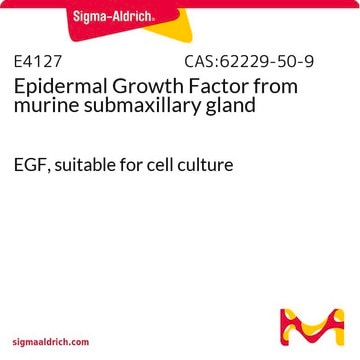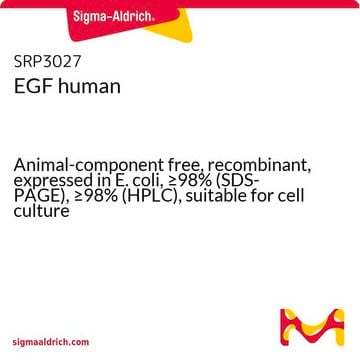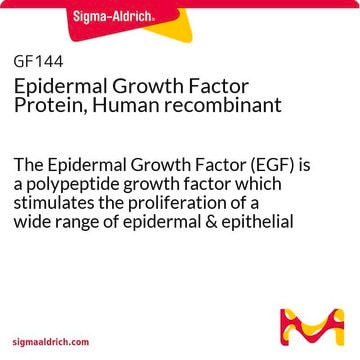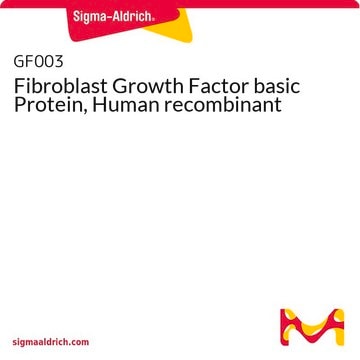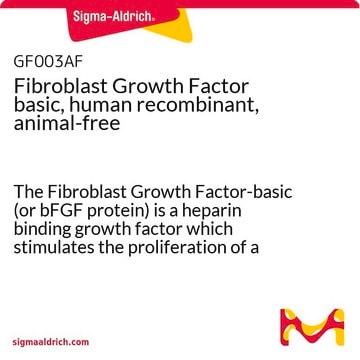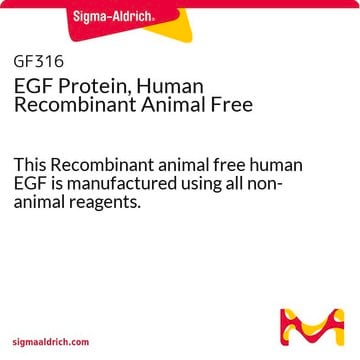The human EFG is synthesized as a long preproprotein of 1207 amino acids. The bioactive fragment (from amino acids 970 to 1023) is released by proteolytic cleavage. Please see the sequence below as well as the link to the Uniprot profile:
https://www.uniprot.org/uniprotkb/P01133/entry
NSDSECPLSHDGYCLHDGVCMYIEALDKYACNCVVGYIGERCQYRDLKWWELR
E9644
Epidermal Growth Factor, human
≥97% (SDS-PAGE), recombinant, expressed in E. coli, lyophilized powder, suitable for cell culture
Sinónimos:
Factores de crecimiento epidérmico human, EGF
Seleccione un Tamaño
$260.00
En stockDetalles
Seleccione un Tamaño
About This Item
$260.00
En stockDetalles
Productos recomendados
Nombre del producto
hEGF, EGF, recombinant, expressed in E. coli, lyophilized powder, suitable for cell culture
biological source
human
Quality Level
recombinant
expressed in E. coli
assay
≥97% (SDS-PAGE)
form
lyophilized powder
potency
0.08-0.8 ng/mL ED50/EC50
mol wt
~6 kDa
packaging
pkg of 5X0.2 mg
pkg of 0.2 mg
pkg of 0.5 mg
storage condition
avoid repeated freeze/thaw cycles
technique(s)
cell culture | mammalian: suitable
impurities
≤1 EU/μg endotoxin (EGF)
color
white
solubility
water: soluble, clear, colorless
UniProt accession no.
storage temp.
−20°C
SMILES string
S(CC[C@H](NC(=O)[C@@H](NC(=O)[C@@H](NC(=O)CNC(=O)[C@@H](NC(=O)[C@@H](NC(=O)[C@@H](NC(=O)[C@@H](NC(=O)[C@@H](NC(=O)CNC(=O)[C@@H](NC(=O)[C@@H](NC(=O)[C@@H](NC(=O)[C@@H](NC(=O)[C@H]%12N(CCC%12)C(=O)[C@@H](NC(=O)[C@@H](NC(=O)[C@@H](NC(=O)[C@@H](NC(=O)[C@@H](N
InChI
1S/C270H401N73O83S7/c1-24-134(19)217(262(420)293-112-201(355)298-161(69-74-205(359)360)229(387)301-160(45-35-82-286-269(279)280)228(386)333-192(119-428)255(413)307-162(68-73-198(274)352)230(388)316-176(94-141-54-64-150(350)65-55-141)241(399)304-159(44-34-
InChI key
GVUGOAYIVIDWIO-UFWWTJHBSA-N
Gene Information
human ... EGF(1950)
¿Está buscando productos similares? Visita Guía de comparación de productos
Application
Biochem/physiol Actions
Funciones celulares afectadas por el EGF: mitosis, flujo de iones, transporte de glucosa, glucólisis, síntesis de proteínas y ácidos nucleicos, supervivencia, crecimiento, proliferación y diferenciación.
Efectos biológicos del EGF: inhibición de la secreción gástrica de ácido , crecimiento y desarrollo fetales, y neuromodulación del sistema nervioso central.
Vías afectadas por el EGF: Comunicación del EGFR, cascada MAPK, PIP, comunicación Ca+2
Components
Caution
Preparation Note
Analysis Note
Storage Class
11 - Combustible Solids
wgk_germany
WGK 3
flash_point_f
Not applicable
flash_point_c
Not applicable
ppe
Eyeshields, Gloves, type N95 (US)
Elija entre una de las versiones más recientes:
Certificados de análisis (COA)
¿No ve la versión correcta?
Si necesita una versión concreta, puede buscar un certificado específico por el número de lote.
¿Ya tiene este producto?
Encuentre la documentación para los productos que ha comprado recientemente en la Biblioteca de documentos.
Los clientes también vieron
Artículos
Human pancreatic cancer organoid biobank (PDAC organoids) with various KRAS mutations to aide in 3D cell culture and cancer research applications.
Role of growth factors in stem cell differentiation and various growth factors for your research at sigmaaldrich.com
Organoid culture products to generate tissue and stem cell derived 3D brain, intestinal, gut, lung and cancer tumor organoid models.
Protocolos
A stem cell culture protocol to generate 3D NSC models of Alzheimer’s disease using ReNcell human neural stem cell lines.
Step-by-step culture protocols for neural stem cell culture including NSC isolation, expansion, differentiation and characterization.
Contenido relacionado
Monitor barrier formation using colon PDOs, iPSC-derived colon organoids, Millicell® cell culture inserts, and the Millicell® ERS. 3.0.
-
what is the full peptide sequence of mature E9644 protein (~6kD)?
1 answer-
Helpful?
-
-
For the reconstitution in 10mM acetic acid and 0.1%BSA, do you use PBS or H20 for the rest of the solution?
1 answer-
After the material is reconstituted in 10mM acetic acid, the material can be aliquoted and stored at 2-8°C for one month, or frozen in aliquots at -70°C or -20°C for longer periods. If the stock solution is very dilute, at a concentration less than 10 ug/mL, then BSA or HSA should be added to a concentration of 0.1% in the acetic acid solution prior to reconstitution in order to maintain the stability of the product.
Helpful?
-
-
What is the molecular weight of Epidermal Growth Factor (EGF) human, Product E9644?
1 answer-
The mature protein has a molecular weight of 6 kD.
Helpful?
-
-
Can Epidermal Growth Factor (EGF) human, Product E9644, be used on rat cells?
1 answer-
This product has been tested for activity using the mouse Balb/3T3 cell line. We have not tested its activity in rat cell culture, but we expect that will also work in that application.
Helpful?
-
-
Can I use PBS to reconstitute Epidermal Growth Factor (EGF) human, Product E9644?
1 answer-
We recommend reconstitution with acetic acid to make sure the entire product will be solubilized. PBS can be used, but the total amount of the protein in the vial may not go into solution. It is best to make a higher concentration in acetic acid, and then dilute into PBS.
Helpful?
-
-
What is the difference between Product No. E9644 and E4269, Epidermal Growth Factor?
1 answer-
Product No. E9644 is the mature EGF protein. Long EGF (Product No. E4269) is an analog of epidermal growth factor comprising the human EGF amino acid sequence plus a 53 amino acid N-terminal extension peptide. Long EGF has been developed as an inexpensive, high quality potent analog of EGF for use as a growth factor supplement for serum-free or low-serum cell culture.
Helpful?
-
-
What is the Department of Transportation shipping information for this product?
1 answer-
Transportation information can be found in Section 14 of the product's (M)SDS.To access the shipping information for this material, use the link on the product detail page for the product.
Helpful?
-
-
How long can I store a solution of Epidermal Growth Factor (EGF) human, Product E9644?
1 answer-
Solution stability can be found on the product data sheet. If Product No. E9644 has been reconstituted with 0.2 micron-filtered 10 mM acetic acid containing 0.1% HSA or BSA to a concentration of not less than 10 ug/ml, it can be stored at 2-8 °C for a maximum of one month. For extended storage, freeze in working aliquots at -70 °C or -20 °C. Repeated freezing and thawing is not recommended.
Helpful?
-
Active Filters
Nuestro equipo de científicos tiene experiencia en todas las áreas de investigación: Ciencias de la vida, Ciencia de los materiales, Síntesis química, Cromatografía, Analítica y muchas otras.
Póngase en contacto con el Servicio técnico
